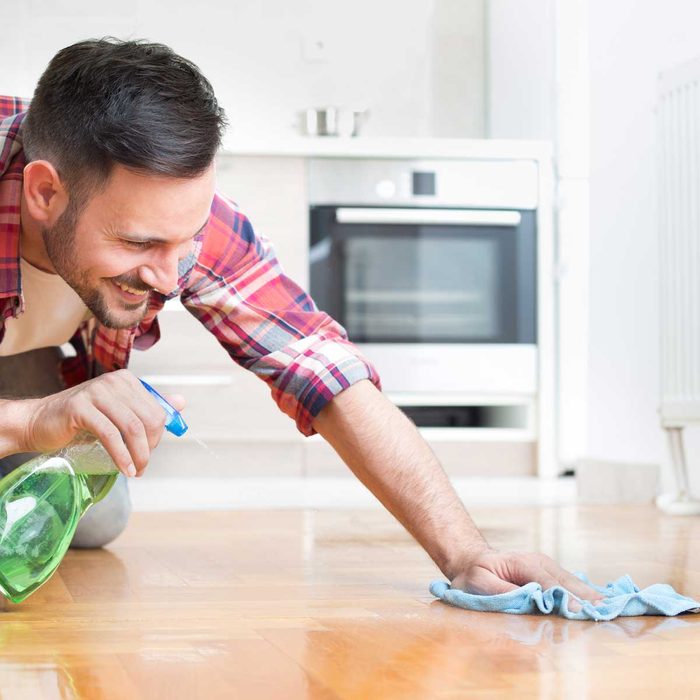
Stop before you mop!
Wood floors are the crowning glory of any home. They’re beautiful, shiny and rich in hue and character. As gorgeous as they are, though, wood floors can sometimes be a bit of a challenge to maintain. They require consistent care and routine cleanings, as well as an understanding of which products are OK to use and which are not. For the full rundown of the products you should never use on your wood floors—and what you ought to be using instead—check out this essential advice from cleaning pros.
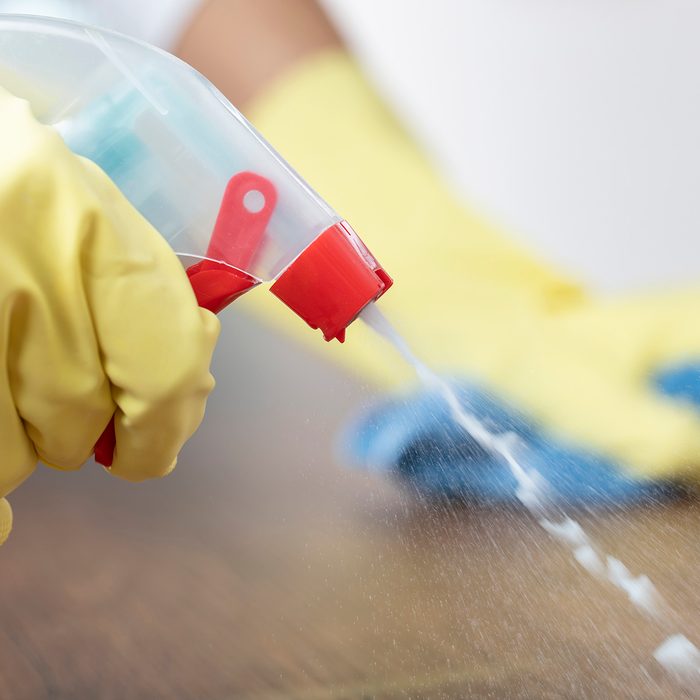
Ammonia
Ammonia is a pungent chemical that has many cleaning uses in your home, but it should never be used on hardwood floors. “The ingredient damages the surface and dissolves the lignin in the wood,” explains Leanne Stapf, chief operating officer at The Cleaning Authority. If you’re looking for a heavy-duty wood floor cleaner that’ll cut through serious gunk, try Zep Commercial Hardwood and Laminate. Bonus: It can also be used on baseboards, cabinet doors and crown molding. A big FYI: When you do use ammonia, never combine it with bleach. That pair is among the cleaning products you should never mix.
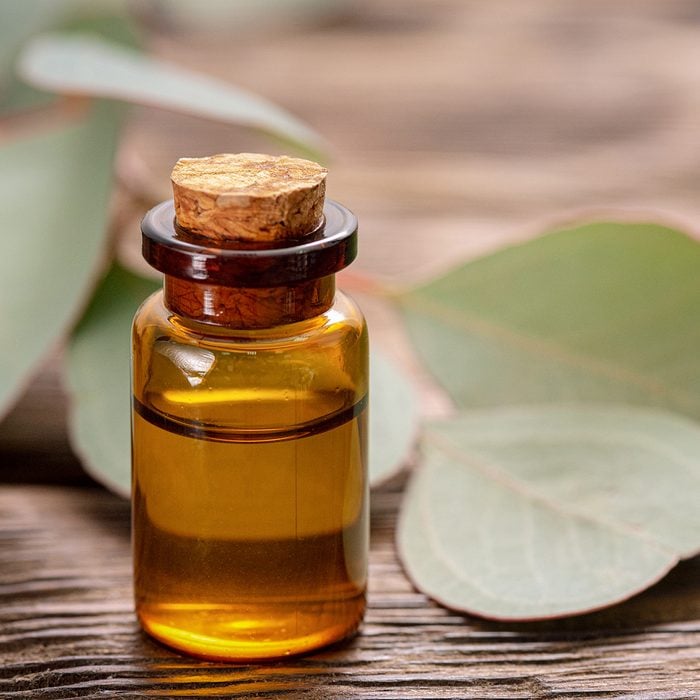
Oil
Speaking of oil and wood floors, let’s set the record straight here. Our cleaning pros tell us that it’s OK to apply small amounts of diluted oil to wood floors to help add a bit of shine. However, too much oil can quickly go south. “It does what oil does: It makes floors slippery—dangerously slippery! And it’s not easy to get that off later,” explains Kadi Dulude, who owns Wizard of Homes NYC. “If you want to use oily products on your floors, then be sure to test a small area first and try walking on the test area to see if it’s too slippery or if it leaves footprints.” A better bet, however, might be Method’s Wood for Good Squirt + Mop Wood Floor Cleaner, which has a very small amount of coconut oil in it and sports an almond scent.
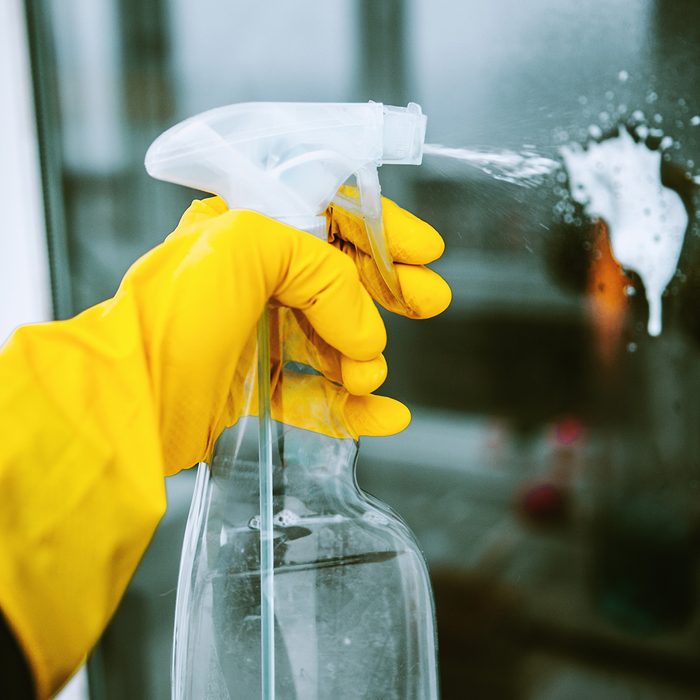
Glass cleaner
Glass cleaners aren’t ideal for wood floors. Some are formulated with abrasive ingredients (such as ammonia) that can actually damage your floors and leave spots, notes Rosa Nogales-Hernandez, head home cleaning valet at Valet Living. Generally speaking, though, there are simply better options to reach for when you want to get your wood floors clean. One good option: diluted Pine-Sol, which was also recently approved by the CDC as an effective way to kill the coronavirus. To use, combine 1/4 cup Pine-Sol and a gallon of water. Spray onto your floors and wipe away with a microfiber cloth. Check out these other things you should never clean with Windex.
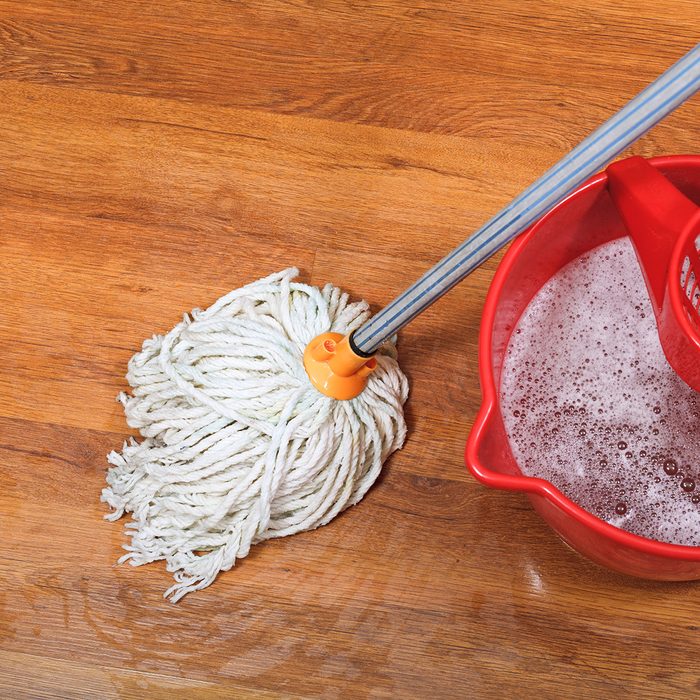
Wet mops
Less is more when it comes to cleaning your wood floors, and that’s especially true when it comes to water. “Mops that are super wet can ruin the finish and damage the wood itself,” says Stapf. “Instead, use a slightly damp mop and wipe away the excess of standing water in order to avoid damage. A slightly damp mop is effective when cleaning stains from the floors.” Bottom line: Any product that requires you to break out the bucket and mop isn’t ideal for wood floors. If you swear by mops and don’t want to give them up, try one that effectively squeezes out excess water, such as the O-Cedar Easywring Microfiber Spin Mop and Bucket System. In case you were wondering, this is how often you should clean everything in your house.
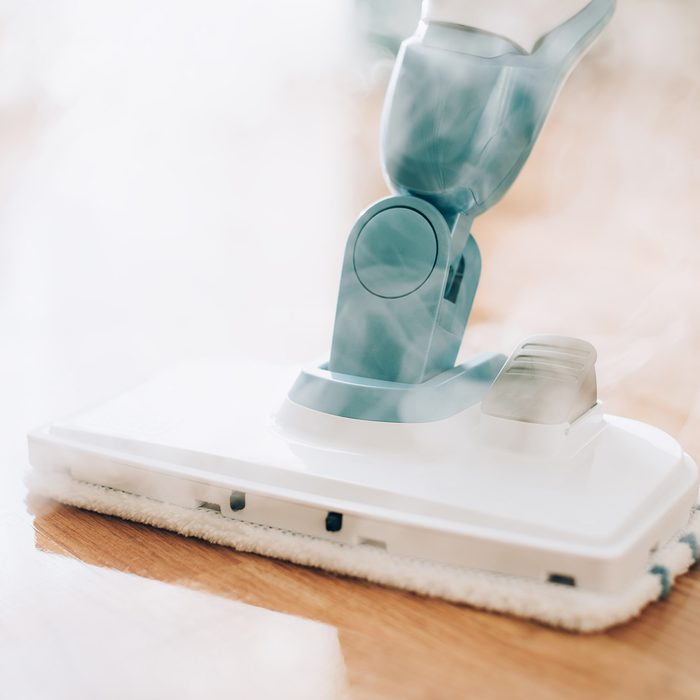
Steam cleaners
On that note, steam-cleaning devices shouldn’t be used on hardwood floors, either. Because of wood’s porous nature, moisture is easily absorbed. “Steam cleaners will leave excessive water and heat on the floors, and this can lead to cupping and long-term damage,” notes Nogales-Hernandez. “I recommend using a microfiber mop when cleaning instead.” Try the Mr. Siga Professional Microfiber Mop on hardwood, laminate and tile floors. And check out this pro tip for problem spots: “For individual scuffs on the floor, you can also rub a tennis ball on the scuffs until they are gone.” Genius! Check out these other clever cleaning hacks from professional house cleaners.
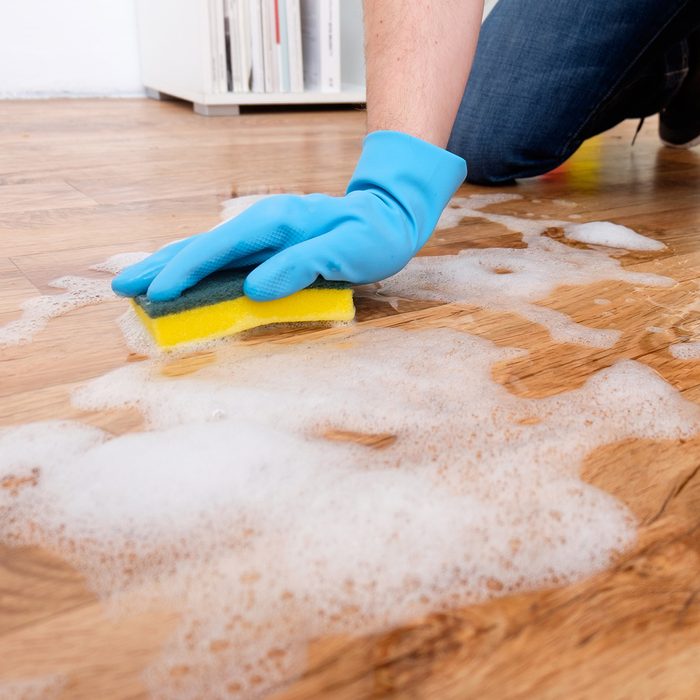
Soap and water
Straight up soap and water works in many cleaning scenarios, but it isn’t an ideal solution for hardwood floors. First, it often requires the use of too much water, which can create damage over the long run. Second, the soap tends to leave a filmy residue buildup on your floors, which can dull shine, attract footprints and scuffs and even create a slippery surface.
You can get that same quick-and-easy clean with the Bona Hardwood Floor Premium Spray Mop, which comes with a washable microfiber pad and a refillable cartridge filled with Bona Hardwood Floor Cleaner. This mop also has soft, flexible corners, so you won’t accidentally damage baseboards as you’re trying to get hard-to-reach spots. While you’re on a cleaning kick, review these cleaning mistakes that are probably making your home dirtier.
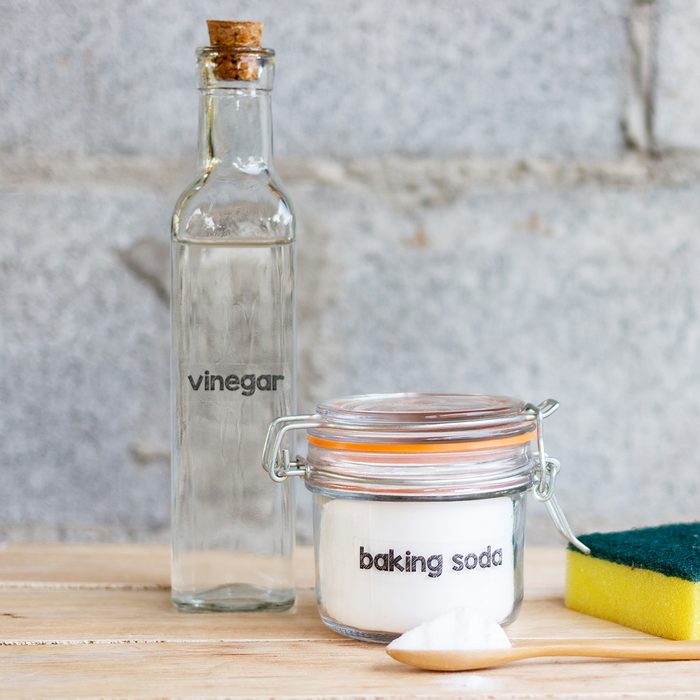
Vinegar
Vinegar is another one of those ubiquitous, highly touted household cleaning products that ought to be used with caution when it comes to your wood floors. “Using too much vinegar and water on your floors can dull them over time,” says Nogales-Hernandez. “This is a commonly recommended cleaning solution, but it can be damaging.” Vinegar should be used sparingly on wood floors or reserved for hard, durable surfaces such as windows, sinks and microwaves, as well as these other things you didn’t know you could use vinegar on.
For maximum clean and shine, she recommends combining 2 cups of warm water with 1/4 cup rubbing alcohol, 1 tablespoon castile soap and 1/2 cup vinegar. Combine in a spray bottle, spray the solution onto your floor and wipe it up with a damp cloth or microfiber mop. When using castile soap, stick to the pure, unscented stuff.
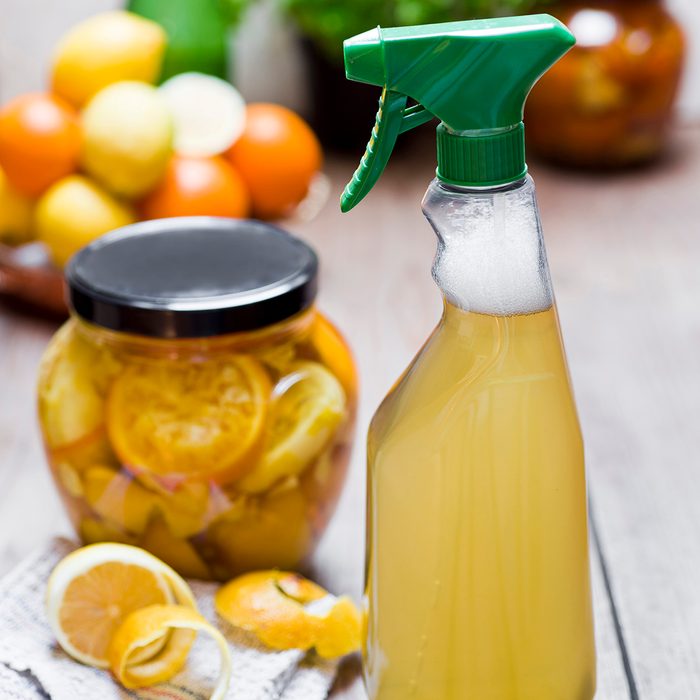
Lemon juice
Like vinegar, lemon juice is a highly acidic ingredient that can disrupt the beauty and integrity of your wood floors—particularly when used in large amounts. Too much can dull your floors and also wear down the finish, making your floors more susceptible to damage over time. If you’re seeking a premade cleaner, both Dulude and Nogales-Hernandez recommend the Bona Floor Care Kit because it’s gentle, safe and effective. If you’re eager to break out the lemon juice, here are some items you can clean with lemons.
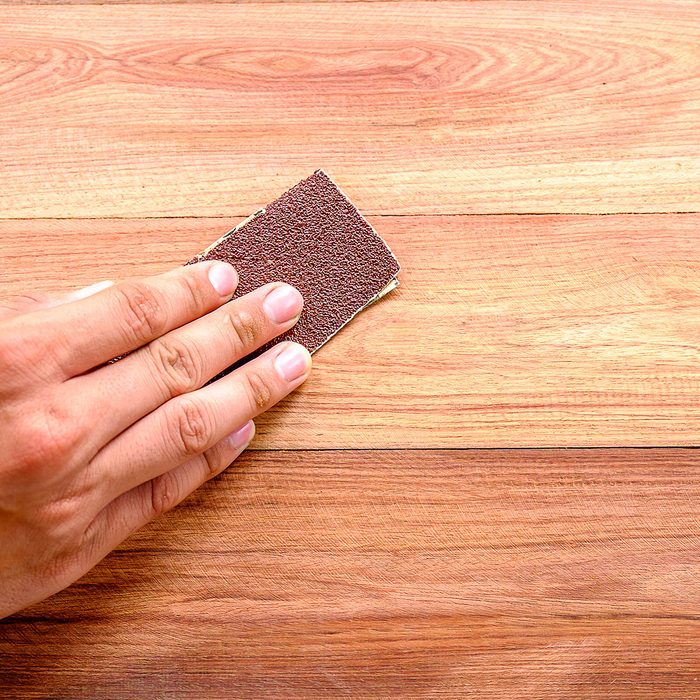
Sandpaper
You might be tempted to smooth out a weird spot in your hardwood floors, but Stapf says this is a recipe for disaster, regardless of the grit you’re working with. “Sandpaper can quickly damage the finish of hardwood floors,” she explains. This not only hinders their beauty but also makes them more susceptible to damage down the road. “If you need to clean stubborn spots off a hardwood floor, rub the stain with steel wool and floor wax until it disappears.” The steel wool still has some grit, but it’s much finer than any sandpaper you’ll find. An alternative is a Magic Eraser, or even a toothbrush.
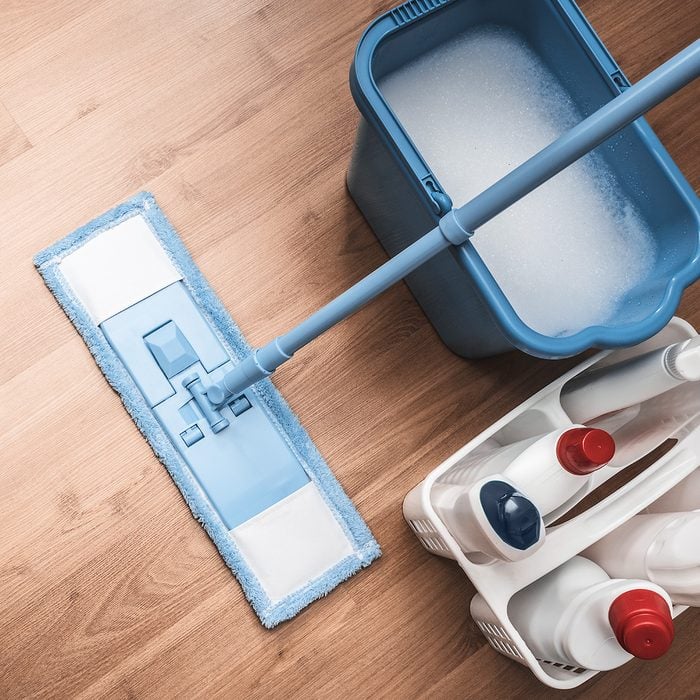
Bleach
When it comes to stubborn stains on your wood floors, stay away from the bleach! “Bleach can discolor the floors permanently, so it is best to keep that away from wood floors altogether,” warns Dulude. You can use the same steel-wool trick outlined above by Stapf, or give an extra durable Mr. Clean Magic Eraser a try. You might also want to pick up these cleaning products professional house cleaners always buy.
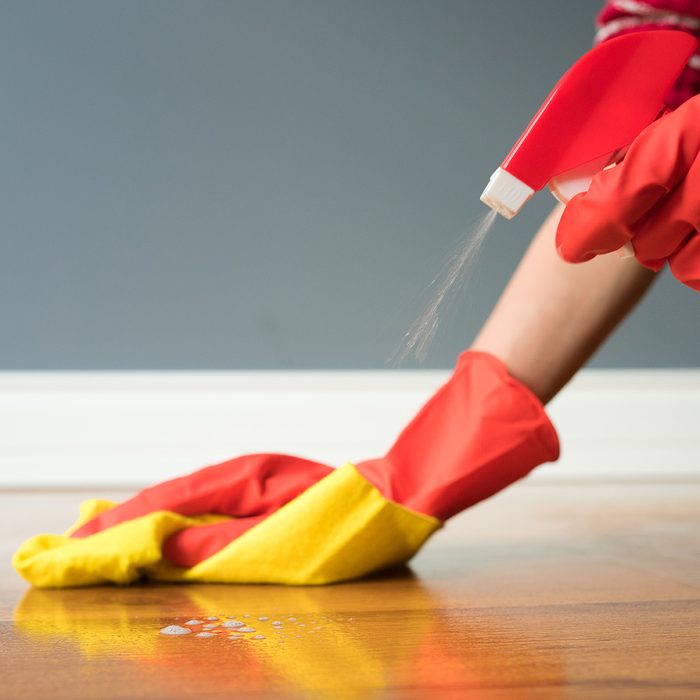
Hydrogen peroxide
Though hydrogen peroxide isn’t quite as potent as bleach, it can easily discolor wood floors when used incorrectly. To avoid any mishaps, Stapf recommends skipping this ingredient altogether and instead use a damp microfiber mop or cloth to clean your floors. The spot-cleaning tricks and tips mentioned above can also be used to tackle stubborn stains and built-up grime.
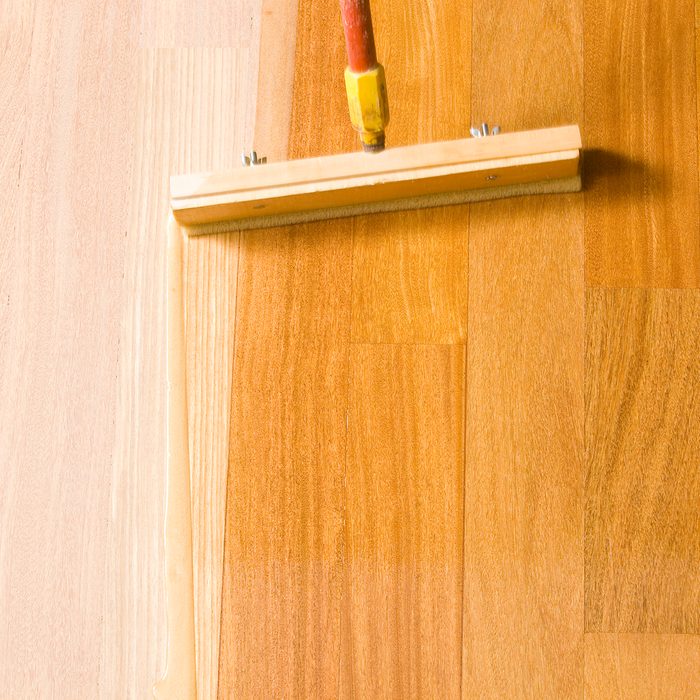
Liquid polish
Don’t be deceived by the abundance of liquid polishing products targeted as safe for wood floors. These often contain large amounts of waxes and oils that will make your floors look great initially but will eventually create a buildup of sticky residue that dulls and discolors. “To give old floors a freshly finished look, you could use Holloway’s Quick Shine, but I’d only recommend it for apartments for sale or rent and not for daily or weekly use,” says Dulude. “If you use it too often, the product will start building up on low-traffic areas and it will not be easy to get it all removed later. But a few coats for a fresh look is OK.” If you’re cleaning your floors regularly, you may not even feel the need for polish!
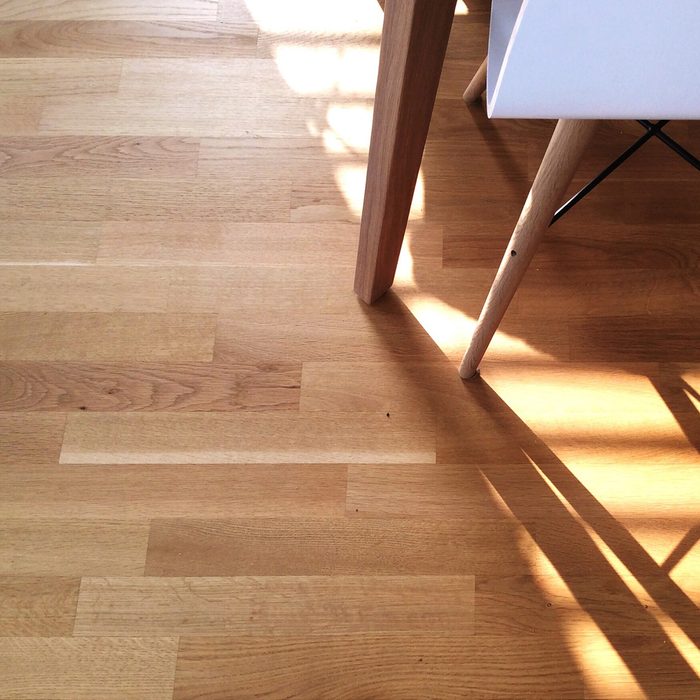
Final tips for maintaining hardwood floors
In addition to the above advice, Nogales-Hernandez says to make sure you clean up all spills immediately to prevent the wood from warping or becoming discolored. She adds, “Ensure you use protecting pads on all the furniture, and don’t drag any furniture on the floor, as this can cause serious damage.” While you’re at it, use rugs in entryways and other high-traffic areas, and consider refinishing your floors every three to five years to keep them protected and beautiful. Next, find out which products will clean your house in less than an hour.